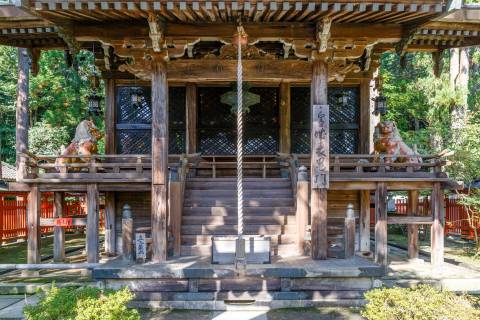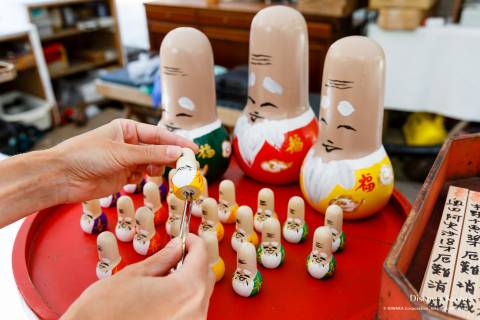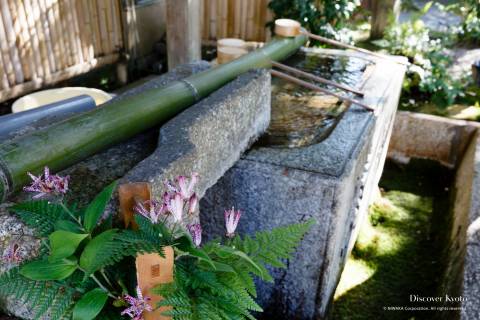Sekizan Zen-in|赤山禅院
Overview

Located in the northeastern area of Kyoto not far from the Shūgaku-in Imperial Villa, Sekizan Zen-in is a relatively small temple that belongs to the Tendai school of Buddhism. Founded in 888, it enshrines Sekizan Daimyōjin, a deity originating from China and introduced by high priest Ennin after studying esoteric Buddhism there. It is also one of the temples on Kyoto’s Seven Gods of Fortune pilgrimage circuit, venerating Fukurokuju, the god of wisdom and longevity. A distinctive feature of Sekizan Zen-in is its two large rings of juzu prayer beads that visitors can pass through for a blessing. Sekizan Zen-in is a more unusual temple with many interesting things to discover, and it is particularly beautiful in autumn when its lush maple foliage turns red.
A distinctive feature of Sekizan Zen-in is its two large rings of juzu prayer beads that visitors can pass through for a blessing.
Features
Monkey Guardian

With a big torii gate as a starting point, the passage going through the temple gate is lined with colorful flags, and you will also notice a gigantic stone lantern immediately beyond the gate. The temple complex of Sekizan Zen-in lies atop a short flight of stairs, with a water basin for purification on the right and a prayer hall at the front. Right in the middle of the roof of the prayer hall you will see a statue of a monkey sitting under a metal net. It is holding a gohei, a wooden wand decorated with zigzag streamers, and suzu bells, both of which are used in rituals for exorcising negative energy. The monkey serves as a sacred guardian, placed here to protect the capital and the Imperial Palace against malign influences coming from the “demon gate” in the northeastern direction. It is said that the monkey used to escape every night to make mischief, which is why it was covered with a net to make it stay in place.
Giant Juzu Prayer Beads

Following the route indicated on the signs, you will come across two large rings of wooden prayer beads, one at the temple’s main hall and another near the end of the route past the Fudō-dō hall. Think of a wish when you step through the first ring and continue to meditate until you pass through the second. If the wish still feels important, pray to the deity for help in your effort to make it come true. Be careful not to step on the beads, as they have the wishes of many people inscribed on them!
In addition to being used to count the number of prayers made, juzu beads represent an important concept of becoming one with the Buddha by chanting mantras. Every year on November 23rd, when the maple leaves are at their most beautiful, Sekizan Zen-in holds its Juzu Kuyō ritual to express respect and gratitude to prayer beads that are no longer in use before laying them to rest with a memorial service.
Main Hall

Passing through a large ring of beads and under a vermilion gate decorated with paper lanterns, visitors pray at the main hall of Sekizan Zen-in. Elevated on the wooden platform of the honden are two large komainu guardians in painted wood, and round wooden plaques with Sanskrit letters can be seen under the roof. It may come as a surprise, as Sekizan Zen-in is a Buddhist temple, but this is a reflection of the syncretism of Buddhism and Shinto worship that existed in Japan in the past. Despite the policy of separating Shinto and Buddhism implemented by the Meiji government, Sekizan Zen-in managed to retain both its temple and shrine aspects, which is most evident in the honden.
Stone Arhat and Kannon Statues

In a spot between the hall enshrining Jizō and the hall dedicated to Benzaiten, one of the seven gods of fortune, you will see 16 moss-covered stone statues of arhats and 33 statues of Kannon against a bamboo grove backdrop. Arhats are disciples of Buddha who have attained enlightenment but remain in the world, protecting the Buddhist faith and awaiting the coming of the prophesied Buddha Maitreya, and they are vividly portrayed here in a variety of postures and facial expressions. Kannon as the goddess of mercy is stated to have 33 forms in the Lotus Sutra, and while the statues are not the exact 33 listed there, the general belief is the same: Kannon appears in many different forms in order to help people in need.
Fukurokuju Hall and Omikuji

Sekizan Zen-in is the oldest of the Miyako Shichifukujin-mairi (Kyoto’s Seven Gods of Fortune) pilgrimage temples, and one of its halls enshrines Fukurokuju, the god of happiness, wealth, and longevity. He is traditionally portrayed as a bald old man with a very high forehead, and the small Fukurokuju figurines that hold the omikuji fortunes offered at the temple are shaped exactly like that! Buy a fortune or an amulet and get your Miyako Shichifukujin stamp here at the small office. You can pray to all the other gods of fortune here, too, as their statues are lined up next to the Fukurokuju Hall.
Sennichi Kaihō Practice

A unique and extremely rigorous ascetic practice called Sennichi Kaihō (“circling the mountains for one thousand days”) carried out by Enryaku-ji temple requires following a prescribed route around Mount Hiei, offering prayers at the various halls, temples, and other holy sites along the way. The practitioners wear white burial robes and special head gear, and carry a dagger and rope symbolizing their readiness to end their life in case of failure. The origin of this practice is attributed to a monk of Enryaku-ji called Sōō, a disciple of Ennin, and it can be ranked among the most demanding physical and mental challenges in the world. The period of one thousand days is spread out over seven years, and during the most arduous sixth and seventh year the route is extended to include a visit to Sekizan Zen-in. Very few monks resolve to embark on this pilgrimage, and only a handful have managed to complete it (just 14 since the end of the World War II and 51 in the existing records since 1571). Sennichi Kaihō was most recently accomplished by Kōgen Kamahori, head priest of Zenjū-in temple in Otsu (Shiga Prefecture) in September 2017.
History
Ennin, the third head priest of the Tendai sect of Buddhism (and the head priest of Enryaku-ji temple on Mount Hiei), also known by his posthumous name Jikaku Daishi, desired to build a temple to honor Sekizan Daimyōjin (originally the Chinese deity Taizan Fukun) who saved his life at sea. Though he could not fulfill this wish in his lifetime, Sekizan Zen-in temple was built by the next head priest Anne in 888, following the will of his master.
The principal object of worship at Sekizan Zen-in is the statue of Sekizan Daimyōjin as a warrior deity. It is the image of the Chinese god Taizan Fukun who protected Ennin from calamities that befell his ship on his way back to Japan after his mission in China. Taizan Fukun is the Taoist great lord of Mount Tai, the eastern mountain of the Five Great Mountains of China, and a god overseeing life and death. He is also one of the most important deities in onmyō-dō. As Sekizan Daimyōjin, he is believed to be an incarnation of Jizō (bodhisattva Ksitigarbha) and is the guardian deity of Enryaku-ji temple. He is considered to be a god of longevity and wealth, connecting him to Fukurokuju.
The repairs of the buildings of Sekizan Zen-in temple were ordered by the retired Emperor Go-Mizunoo (1596–1680) when he visited Shūgaku-in Imperial Villa. He also presented a scroll with “Sekizan Daimyōjin” written by his own hand, and the calligraphy is replicated on the name plate on the big torii gate in front of the temple.
Around the Edo period, a custom of worshipping at Sekizan Zen-in on the 5th day on the month, the festival day of Sekizan Daimyōjin, arose among the merchants in the area. It was believed that this would ensure efficient loan collection. As a result, with time Sekizan Daimyōjin also became a deity to pray to for overall business prosperity. Today, Sekizan Zen-in holds special Buddhist services on the 5th, 15th, 25th, and 28th of the month.
Events
January 1st | Hatsumōde |
|---|---|
January 5th | Hassen-mai Ōgomaku Fire Purification Ritual |
February 3rd | Setsubun |
May 5th | Taizan Fukun-sai and Boy’s Day Ritual |
September, Harvest Moon | Sponge Gourd Incantation for Healing Asthma |
November | Momiji Festival |
November 23rd | Juzu Kuyō (Rosary Memorial Service) |
Access
Address
〒606-8036 京都市左京区修学院開根坊町18
| TEL | 075-701-5181 |
| WEB | http://www.sekizanzenin.com/ |
Admission
- General Admission: Free
Hours
- General Admission: 09:00 – 16:30
- Closed: Never
Transportation
- From Demachiyanagi Station ⇒ Eizan Railway ⇒ Shūgaku-in Station ⇒ 20 minutes walking
- From Kyoto Station ⇒ City Bus Route 5 ⇒ Shūgaku-in Rikyū-michi Bus Stop ⇒ 15 minutes walking
Gallery
-




 +25
+25
